India’s Electric Vehicle Market: A Look Back at 2023 Get...
Read MoreVineet Dravid
Founder & CEO oorja
oorja’s hybrid-based simulations allow you to design and evaluate battery packs under various temperatures and operating scenarios
Given that batteries are the most crucial and heaviest component of an electric vehicle, automotive engineers face numerous design challenges when it comes to the battery design, especially around aspects such as thermal and material safety and durability. For instance, how do I design the cooling or heating system to ensure optimal temperature range of the battery pack? At what temperature would the battery begin to degrade, risking explosion?
Thermal management plays a key role in ensuring optimum and efficient EV battery performance. In this blog, we will take a look at thermal management challenges and key strategies using simulation.
Key factors that affect thermal management
• Key factors that affect thermal management
External factors such as location, seasons and time of the year decide the ambient temperature conditions. Batteries do not perform well when it is too hot or too cold. Poor thermal management will affect the charging and discharging power, service life, cell balancing, capacity, and fast charging capability of the battery pack. For instance, with just a 10-degree rise in the temperature, the battery life will reduce by 50%. For example, the scorching hot summers in Delhi is likely to expose the battery pack to constant hot temperatures for a prolonged period. This results in self-heating and a possible explosion.
While subjecting batteries to extremely high temperature (>50°C) is risky, low temperature is equally harmful. At very low temperatures, that battery degrades faster than it should. Hence, it is crucial to maintain the homogeneity of the temperature distribution within a battery pack.
• Fast-charging
While the trend of fast charging is catching up, batteries touch considerably high temperatures during the charging process. This results in cell degradation and shorter battery life span.
• The person behind the wheel
Driving in high-speed modes for long durations and revving to increase speed can affect the cells of the battery pack.
Using simulation for better thermal management
Discovering the most appropriate thermal management strategy for a electric vehicle design can be taxing. oorja’s hybrid physics-ML based solutions can help engineers look at design performance of EV batteries for various environments and operational conditions. This will replace the conventional “physically test-and-fix method” which is expensive and time intensive.
In the current battery design process, vehicles are designed first and then the leftover space is allocated to the pack. This space constraint on the battery pack constricts engineers and leaves them no room for designing and predicting cooling strategies. They need to study the enclosure material and its placement from cells, type of filler materials used between the cells to determine how well the temperature is maintained within the desirable range.
With oorja energy, engineers, and product managers can predict, analyze, and design battery packs, evaluating them for different operating conditions. Here are a few sample cases/challenges that engineers encounter during battery design.
Case I: Optimizing battery pack design
A sub-optimally designed battery pack reaches higher temperature fast and does not maintain temperature homogeneity. According to the best design practices in the EV industry, the temperature range should be kept below 6 degrees for a vehicle to perform efficiently.
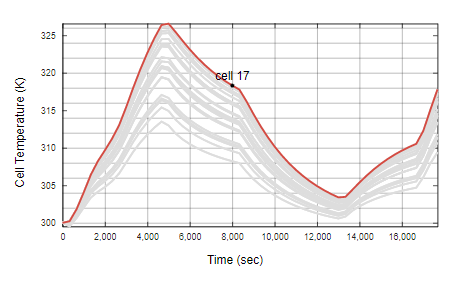
Let us consider a poorly designed 10S4P pack of 18650, 2.5Ah cells. The pack consists of a single layer, with cells arranged in a 10×4 configuration and separated by 1mm. Using oorja, the pack is virtually evaluated under a user-defined drive cycle at 25°C ambient temperature and without active cooling. As a result, the pack not only reaches higher temperatures rapidly (Fig. 1), but it also fails to maintain temperature homogeneity (Fig. 2).
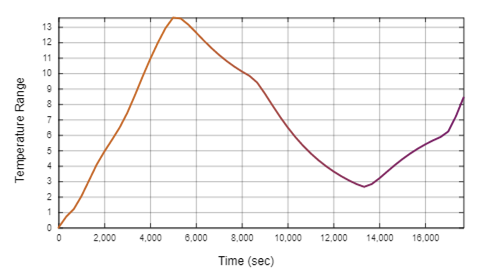
Thus, a better battery design, such as a better arrangement of cells or a better cooling strategy, is needed to reduce the maximum temperature of the pack. Moreover, these optimized design parameters should ensure that temperature heterogeneity is reduced to improve the cycle life of the battery.
Case II: Effect of design parameters
Densely packed cells in a battery pack ensure that the heat is eliminated fast through thermal conduction. However, the same design strategy may not work when thermal runaway gets triggered in a cell as those higher temperatures will also get rapidly transmitted to the neighboring cells.
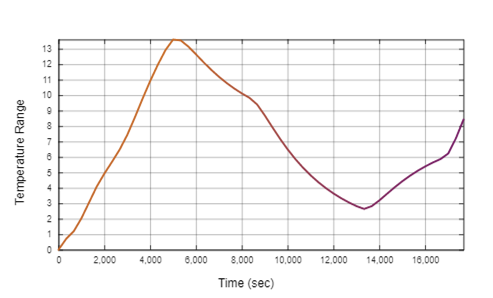
The 10S4P pack discussed above is assessed for two different designs as explained in Fig.3 and Fig 4. As one can see, the cell-cell spacing has a significant influence on the temperature homogeneity of the pack. Though more spacing ensures better temperature uniformity (Fig. 4), poor conduction may lead to higher pack temperatures, particularly if the appropriate cooling strategy is not considered.
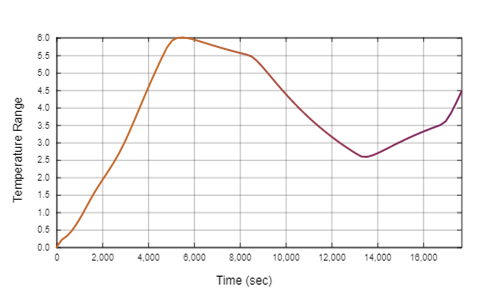
Using oorja’s Thermal Management app, you can adjust the cell spacing while keeping in mind space constraints as well as cooling options, so that you can achieve a greater degree of temperature uniformity.
Case III: Effect of operating conditions
Let us study the effect of ambient conditions and drive cycles on the cell. Here the same pack is exposed to 45°C and 25°C to understand its thermal signature under various ambient conditions. This helps in understanding how the pack will respond when used in different cities/during the different time of the year, when the weather conditions are extremely different. Similarly, the pack is assessed for multiple drive cycles to see its thermal response under varied loading conditions.
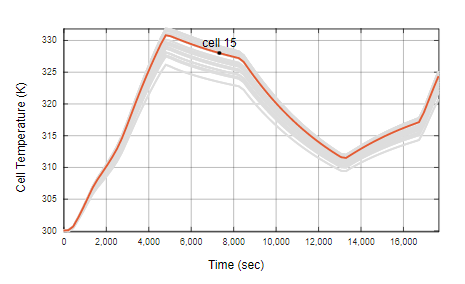
The study below examines the thermal signature of the same 10S4P pack referenced earlier under varying ambient temperatures, such as 25°C (Fig 5) and 45°C (Fig 6).
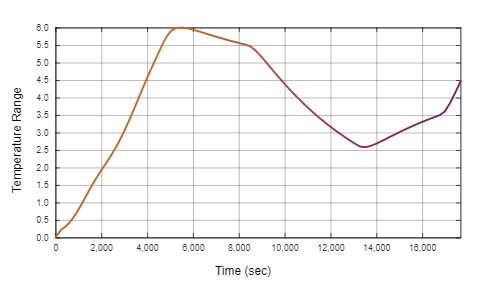
Clearly, a higher ambient temperature increases the maximum temperature of the pack and holds it at the elevated temperature for an extended period of time.
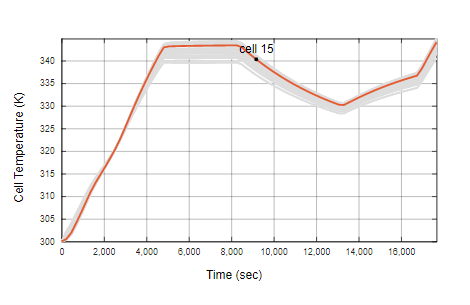
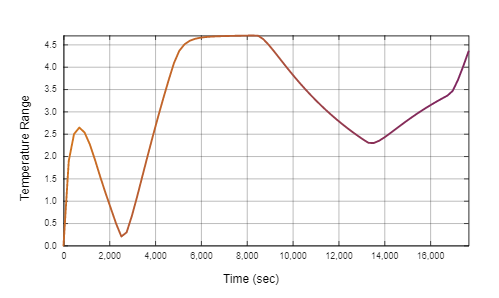
Similarly, the pack is assessed for multiple drive cycles like US06 and MIDC (Fig 7) to see its thermal response under varied loading conditions.
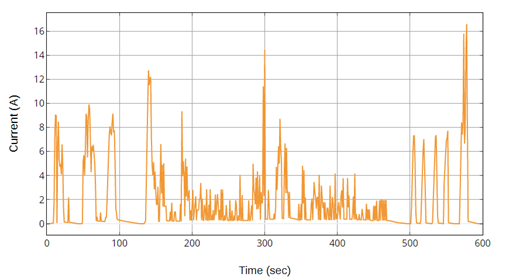
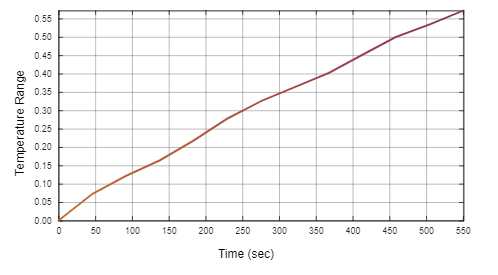
Such an exercise helps in understanding how the pack will respond when used in different cities/ during the different times of the year when the weather conditions are extremely different.
Case IV: Effect of cooling strategies
When the pack exceeds the favorable temperature window, the temperature must be brought down by providing appropriate cooling mechanisms. For an air-cooled pack where an external fan is provided, the temperature can be brought down significantly. However, due to the space constraints, especially in two wheelers, we do not have the luxury to provide any separate cooling method and one needs to rely on natural convection.
Fig. 8a, 8b show the thermal response of the battery pack when forced convection is used as a cooling strategy. As compared to the pack design where just the natural convection (Fig 9a and 9b) is provided, the pack with forced convection cools down faster. However, since it is a densely packed battery pack, it leads to a higher temperature range too.
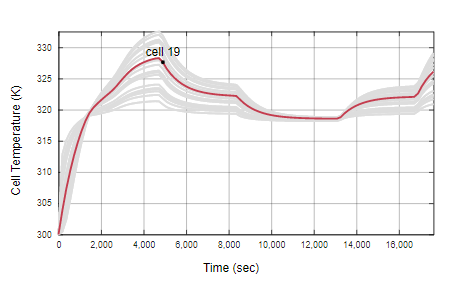
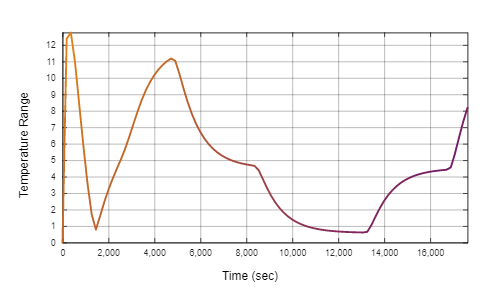
Other cooling methods such as introducing thermal pads or phase-change materials (PCM) inside the battery pack can be considered. These methods will help remove the excess heat from battery packs.
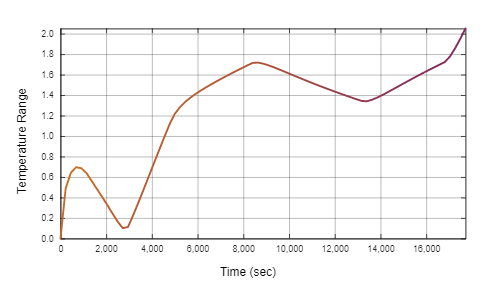
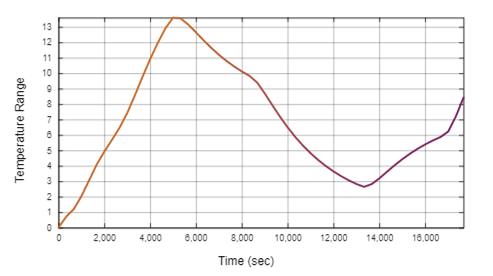
While simulation is a great way to remain competitive in an industry where efficiency, cost, and superior design win the day, it is also efficient to predict temperature and environmental conditions that help design successful electric vehicles.
Get in touch with us to use oorja to design battery packs under various temperature conditions and operating scenarios.
Latest Blog Posts
Hybrid Modeling: Bridging Physics and Machine Learning
Hybrid Modeling: Bridging Physics and Machine Learning Get Started Contact...
Read MoreAccelerated Degradation Predictions using Hybrid (Physics+ML) Simulations
Accelerated Degradation Predictions using Hybrid (Physics+ML) Simulations Get Started Contact...
Read More


